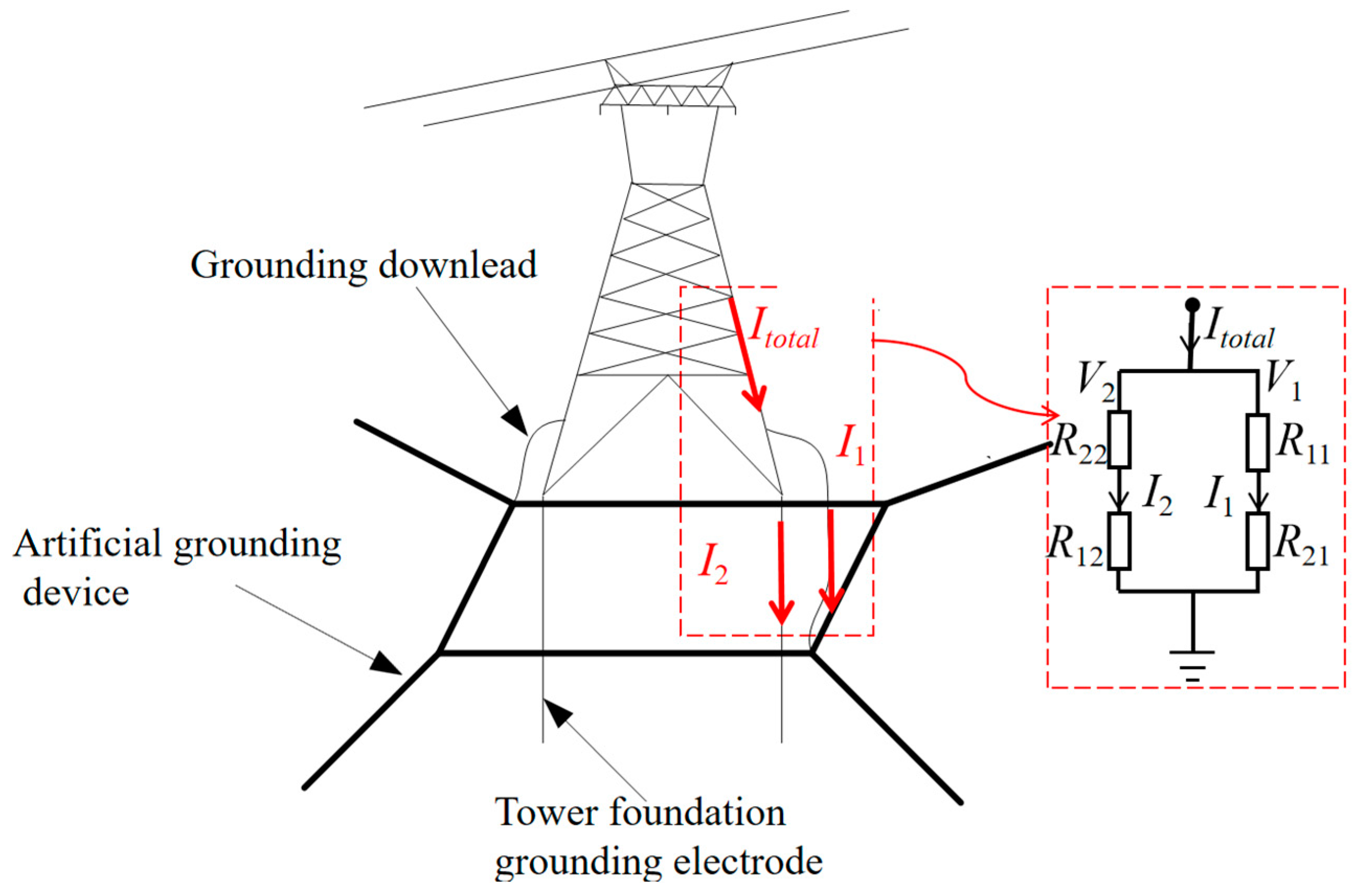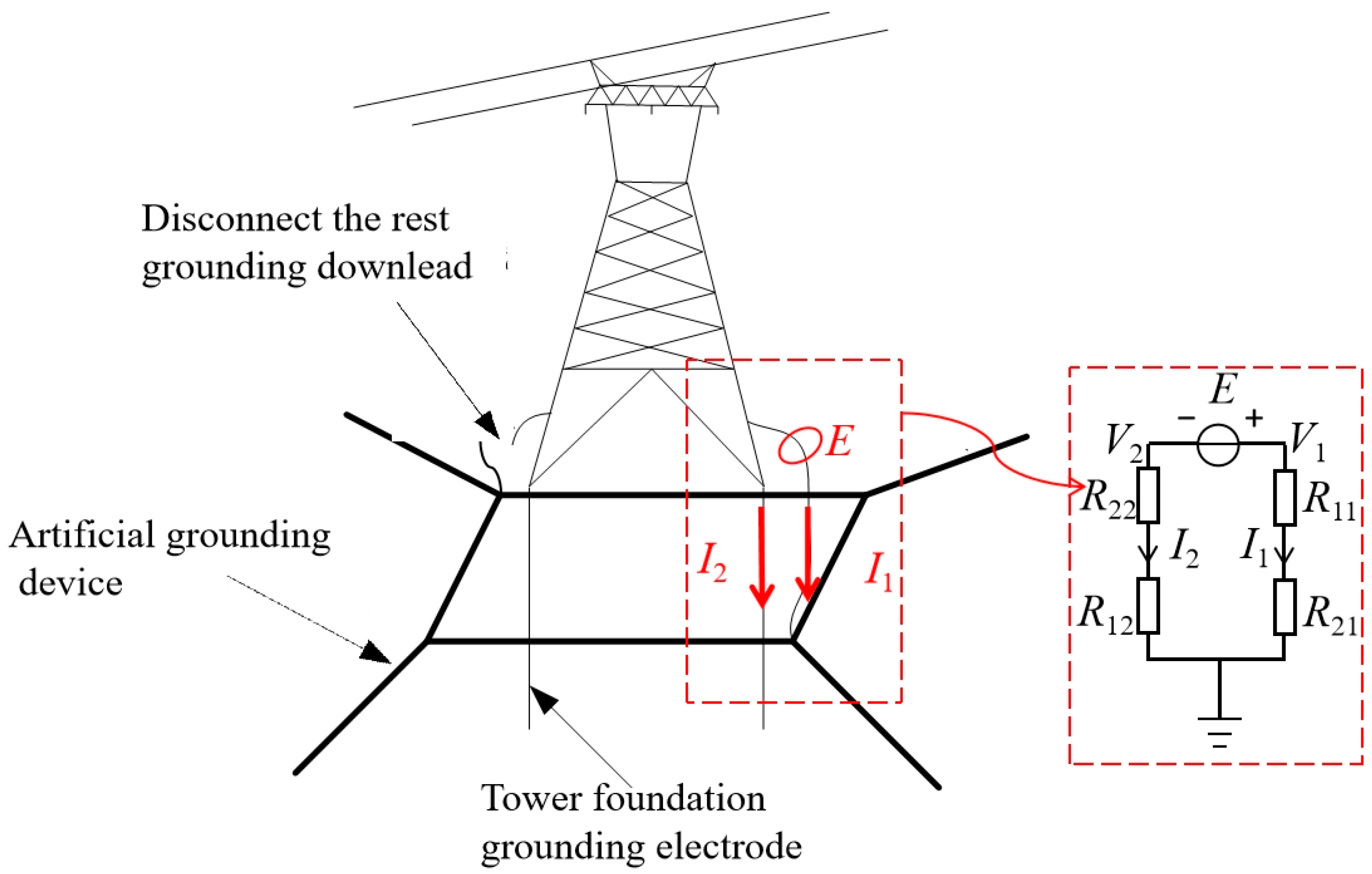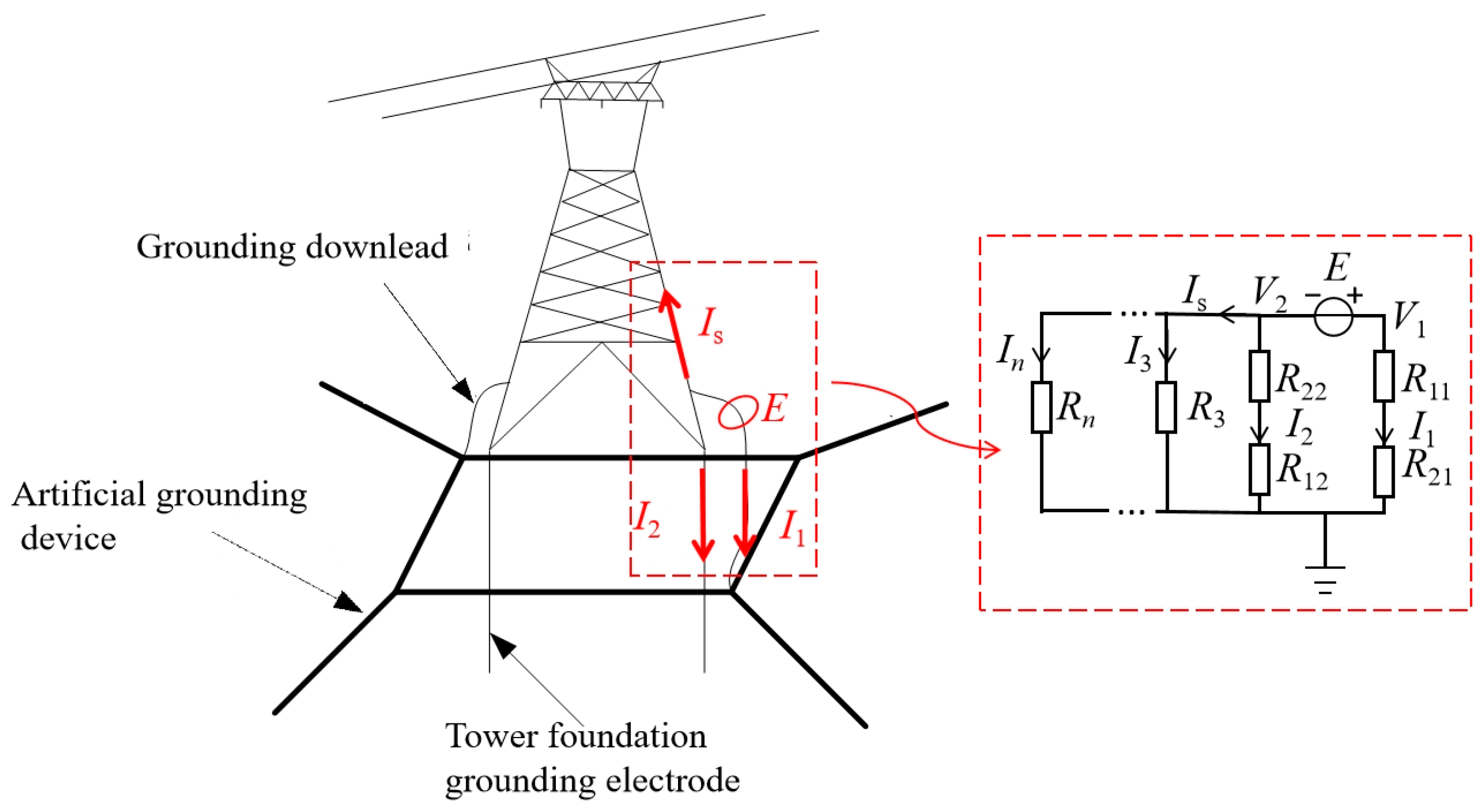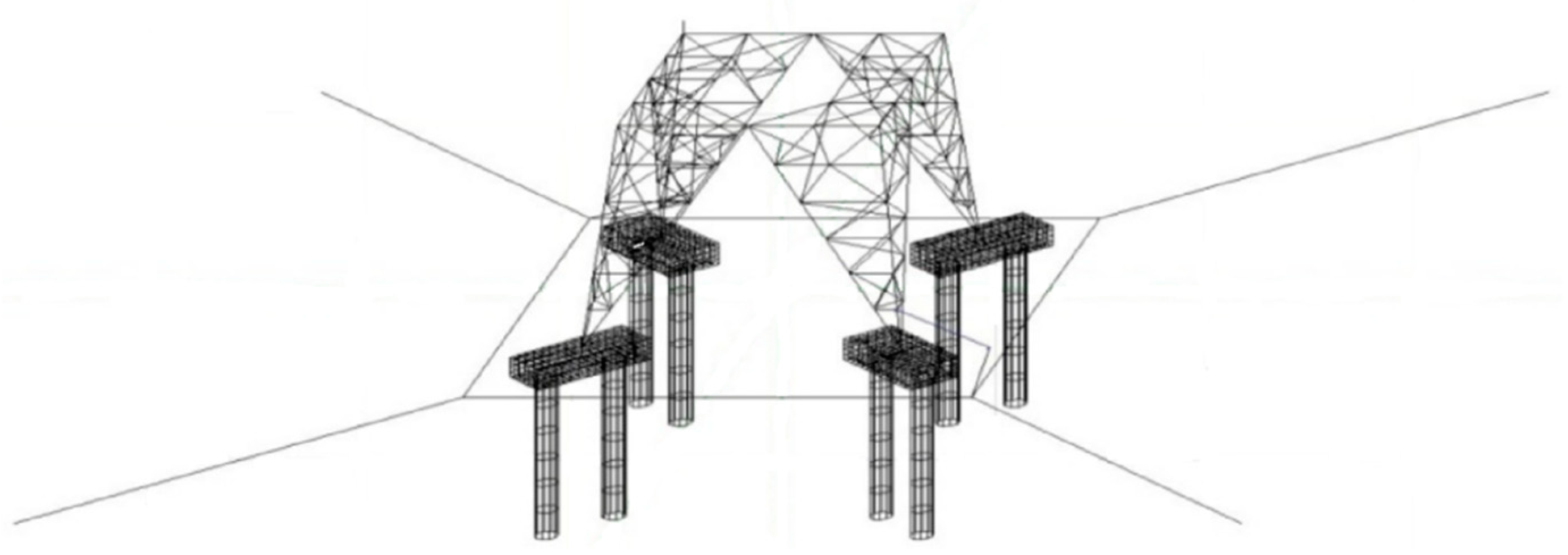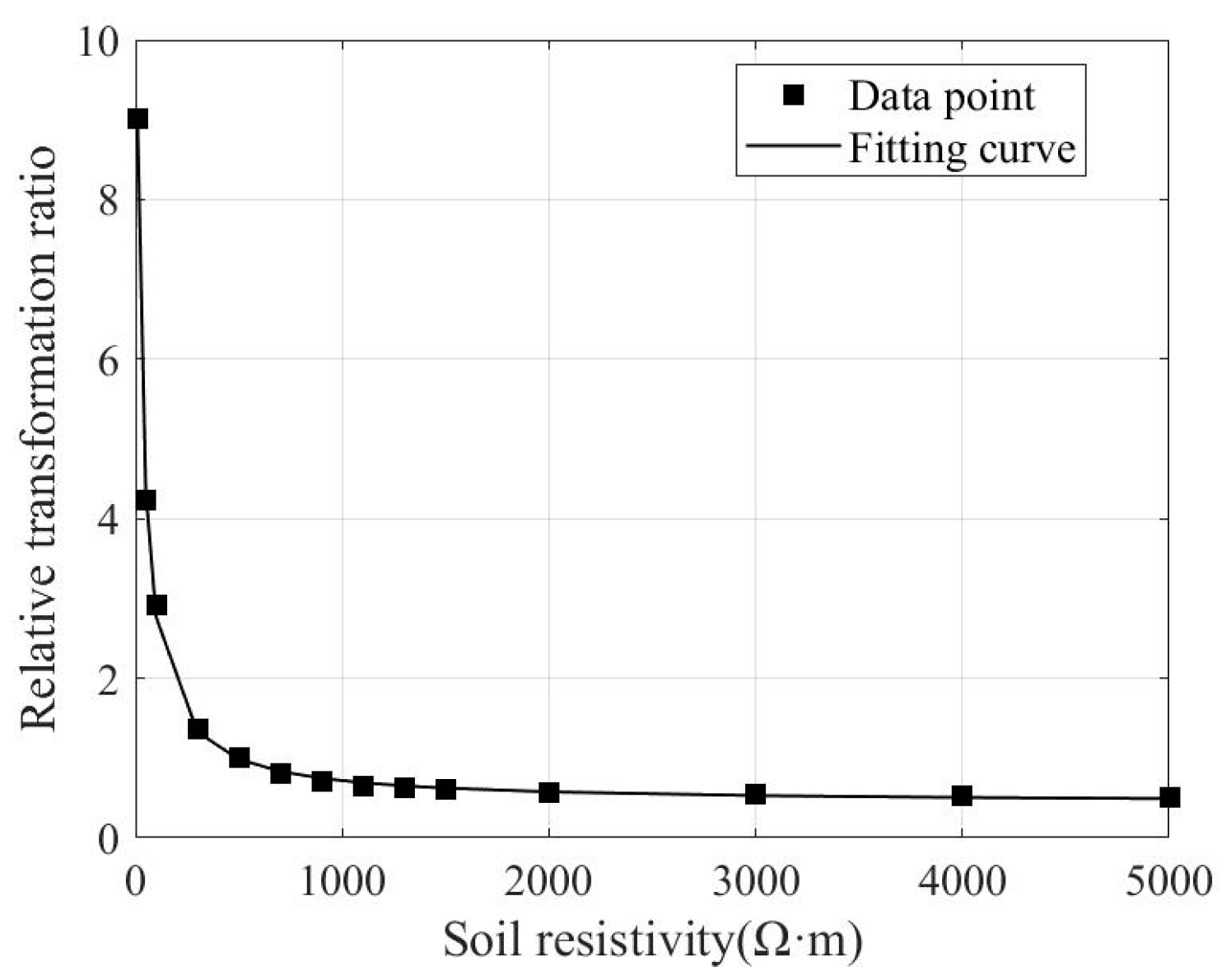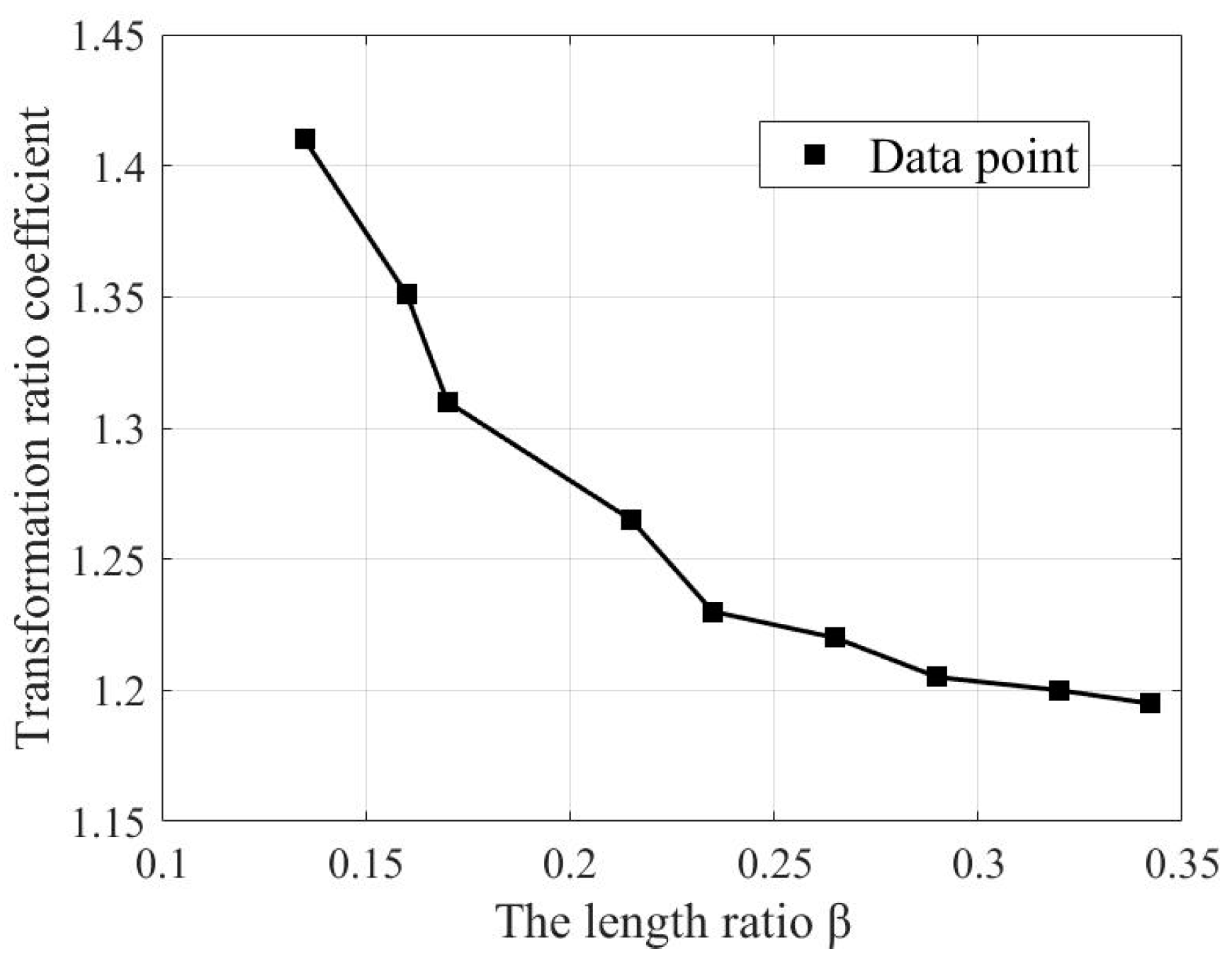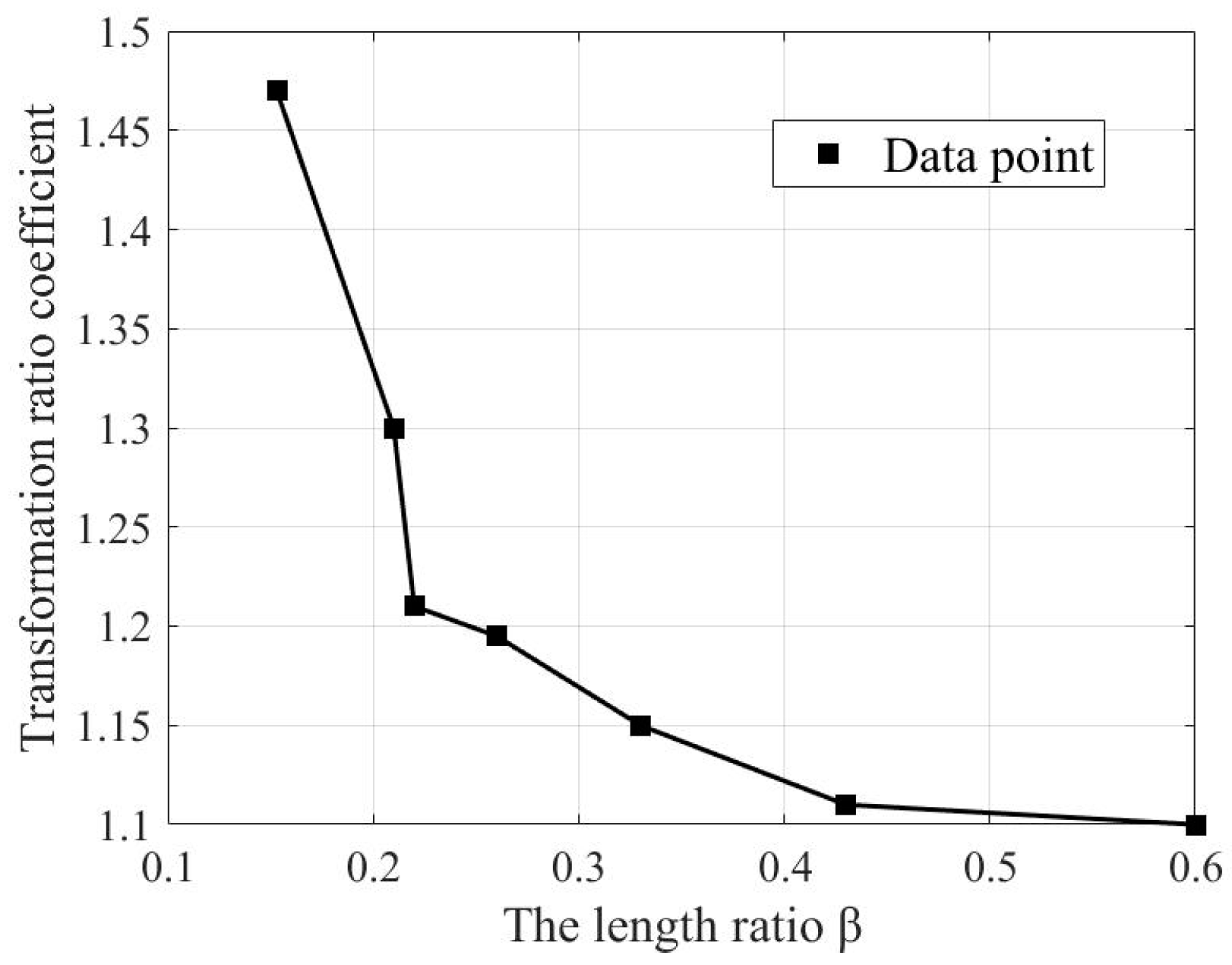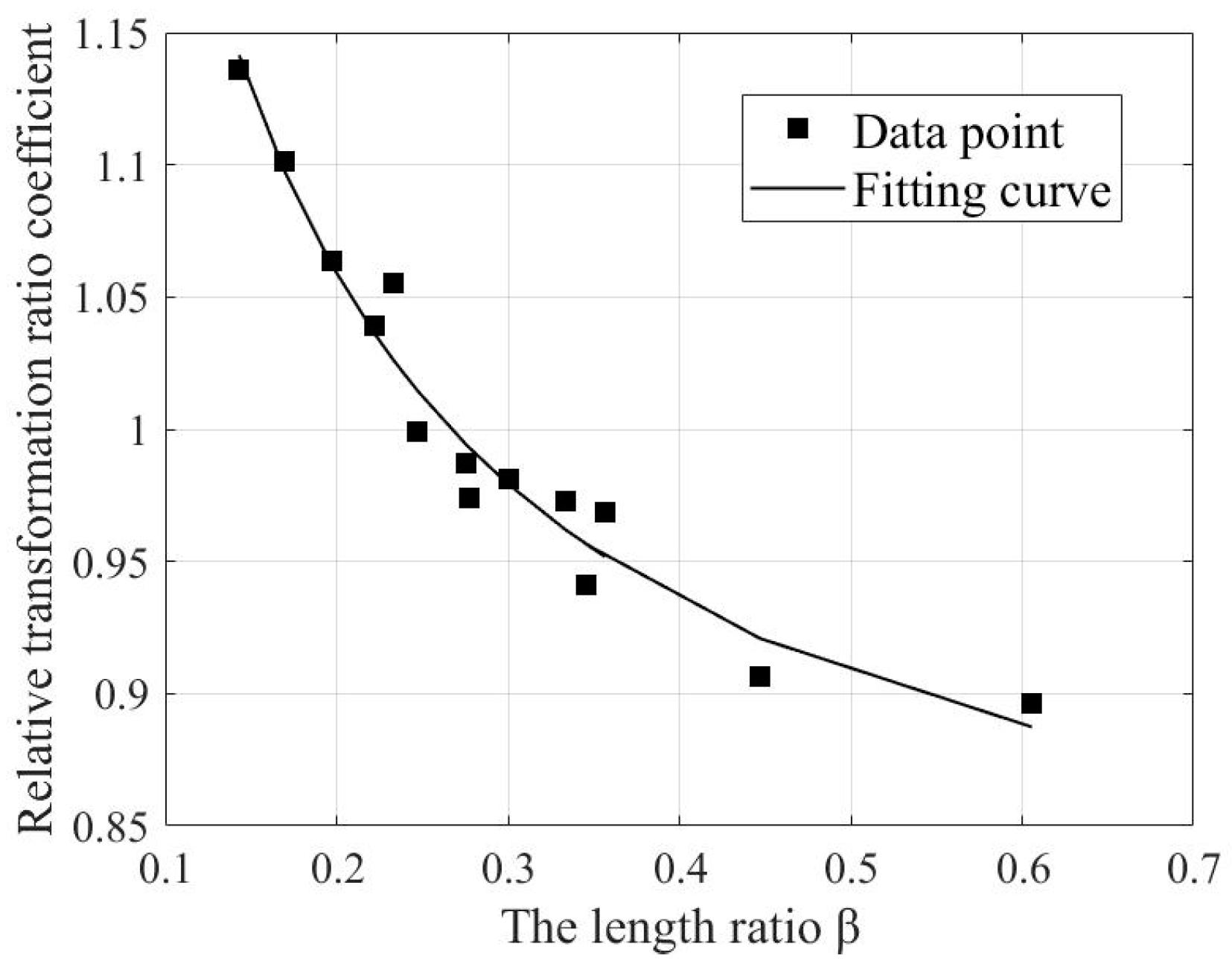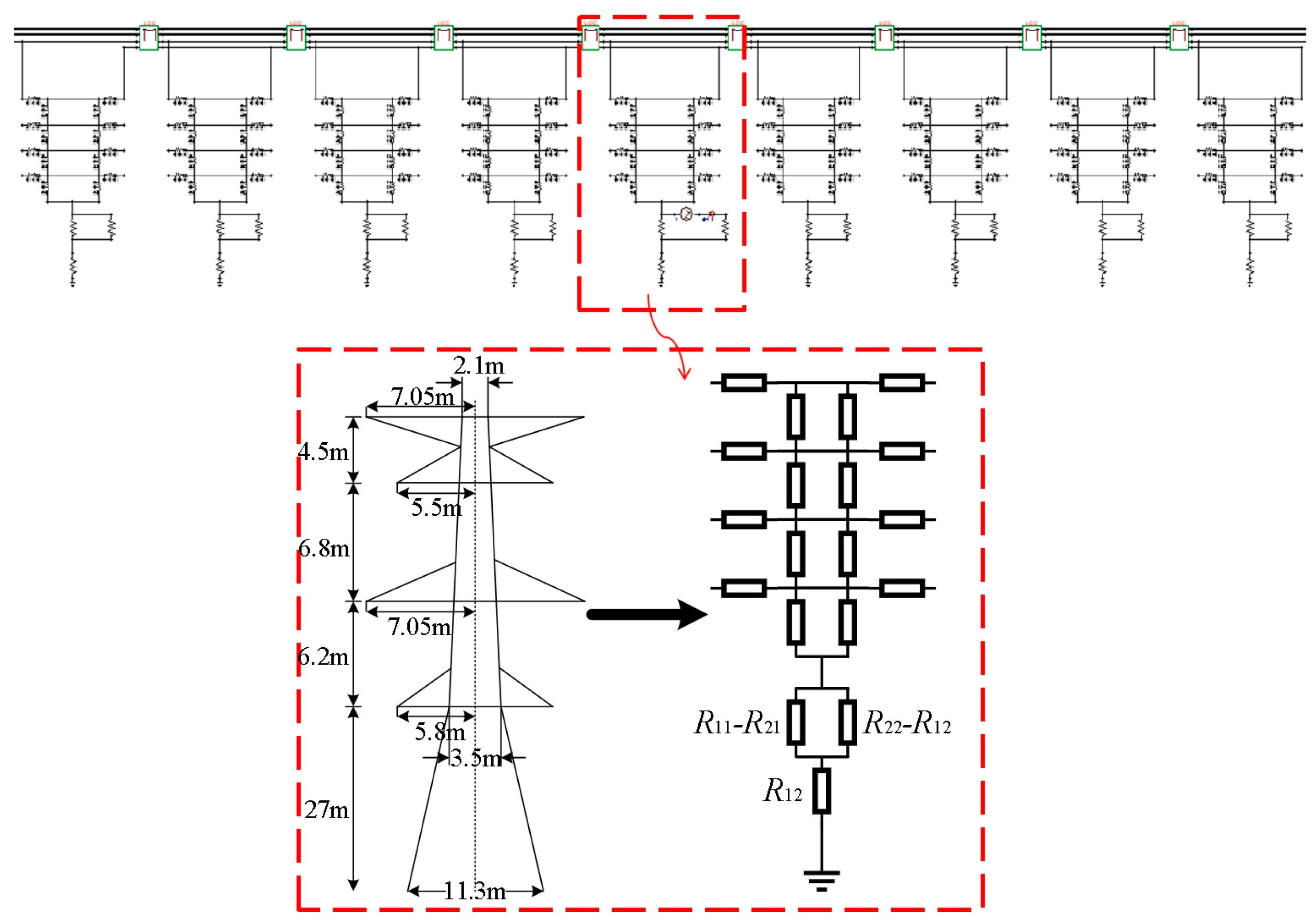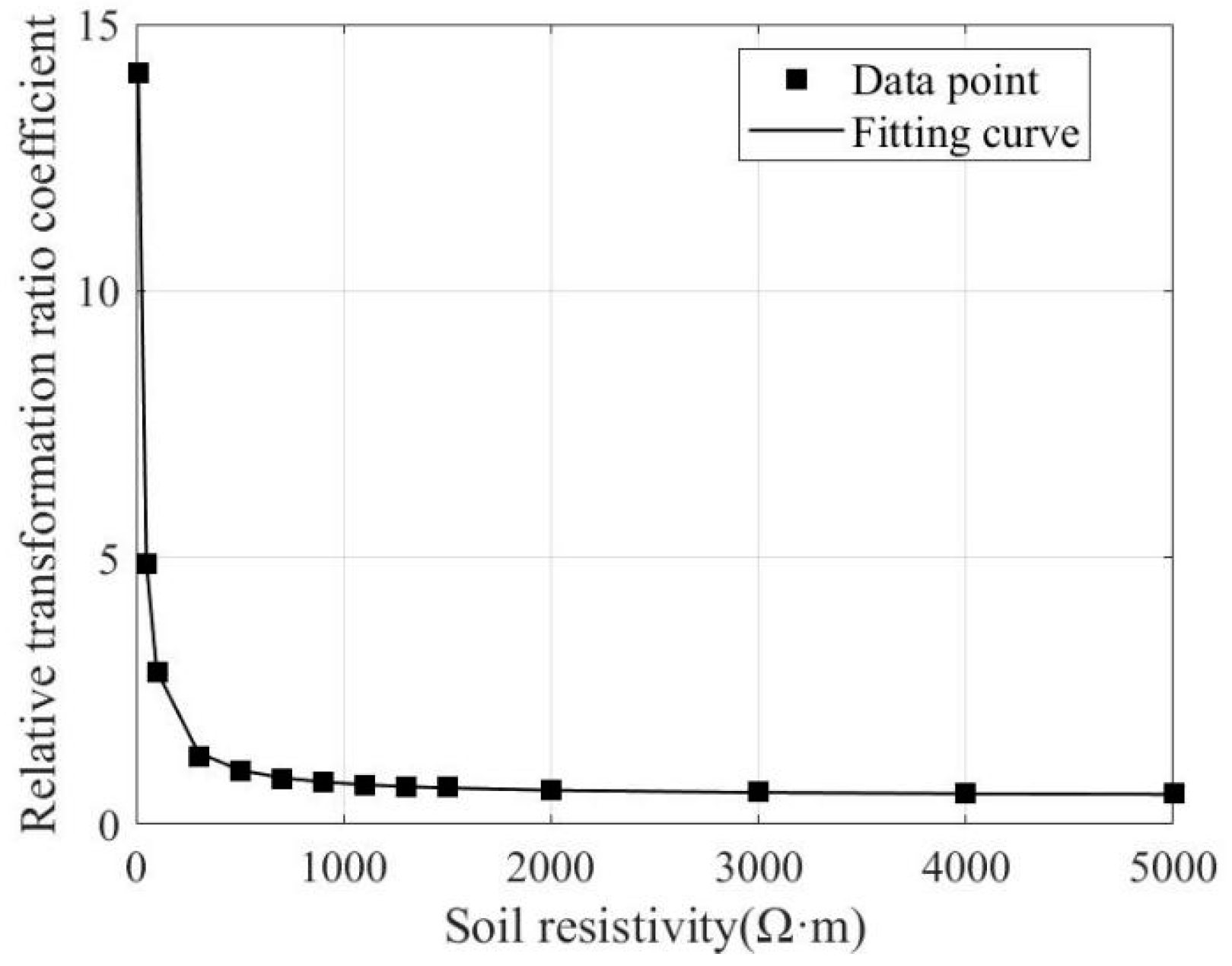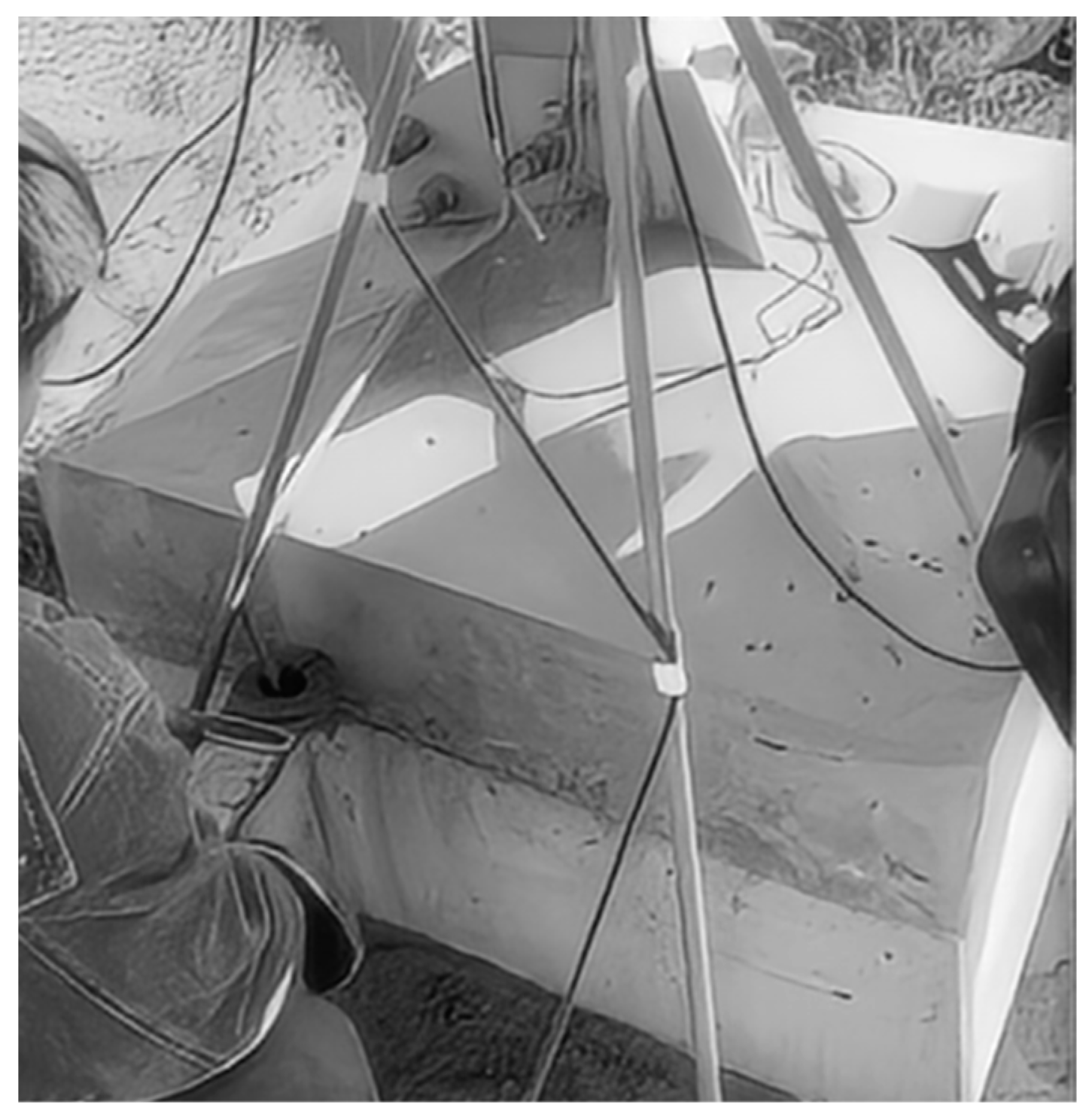1. Introduction
When verifying the grounding performance of towers for their sustainable operation, precise measurement of their grounding resistance is essential to determine compliance with standards [
1,
2,
3]. Lower tower grounding resistance plays a significant role in maintaining a reliable power supply [
4]. If the grounding resistance does not meet the requirements, a ground short-circuit fault in the transmission line can generate a high fault potential, causing significant safety risks to nearby personnel and equipment. Traditionally, the grounding resistance of towers is measured by using the three-electrode method, which requires setting up a test electrode of at least tens of meters, making it time-consuming and labor-intensive [
5]. Moreover, if the tower is located in mountainous areas, the conventional three-electrode testing method becomes difficult to implement [
6]. The potential drop method for measuring grounding resistance requires repeated measurements, involves a large workload, and makes it challenging to plot the potential drop curve [
7]. The high-frequency parallel method does not comprehensively consider the influence of field soil properties and measurement current frequency on the inductive effect of the grounding electrode, making it less adaptable to field conditions [
8]. In contrast, the clamp meter method does not require auxiliary electrodes. It is only necessary to disconnect the grounding downlead of the measuring tower, leaving one downlead, and use a clamp meter around this grounding downlead to take readings, which significantly reduces the workload for measurement personnel [
9].
As for the grounding device of towers, the literature [
10] has conducted simulation modeling and analysis of typical tower foundation grounding in layered soil. The literature [
11] has equivalently modeled the tower foundation as a cylinder and proposed a method for calculating the grounding impedance of the tower foundation. But in practice, the tower grounding consists of both an artificial and a tower foundation grounding device; their mutual influence should be considered. Another study simplified the calculation of tower grounding resistance by considering self-resistance and mutual resistance coefficients [
12]. However, the clamp meter method gains the overall resistance within the entire current flow loop [
13]. For a single tower without a connected lightning shield wire, the artificial and tower foundation grounding device form a series loop through the grounding downlead, the main material of the tower foot, and the soil [
14]. For multi-tower scenarios, previous studies usually consider the current flow loop formed by the measuring tower and adjacent towers connected through lightning shield wires. The measurement reflects the equivalent impedance of the tower body, the lightning shield wire, and the adjacent towers on both sides [
15]. The literature [
16] has analyzed the impact of various factors on the grounding resistance testing of single-tower and multi-tower scenarios. However, the analysis is not comprehensive enough, as it does not consider the influence of different foundation grounding and artificial grounding device sizes on mutual inductance and the final test results. Additionally, for factors with a significant impact, no correction formulas for the measurement results have been provided and used in field tests.
Therefore, in order to measure tower grounding resistance more accurately using a clamp meter, theoretical deductions are conducted and theoretical formulas of the errors are derived considering both single- and multi-tower scenarios in
Section 2. However, the values of self-resistance and mutual resistance in these formulas are unknown in practice, making it impossible to calculate the correction formulas theoretically. Thus, simulations of the clamp meter test results under different influencing factors are further performed. Correction formulas for the factors with a significant impact are fitted in
Section 3 and
Section 4. Finally, a case study is conducted in
Section 5 to verify the feasibility of the proposed correction method.
2. Principle of Clamp Meter Measurement
The clamp meter method generates a test current in the grounding loop through the principle of electromagnetic induction. The power coil A induces an electromotive force E in the loop under test, generating a current I, which is measured by the measuring coil B. For the loop resistance Z, we have Z = E/I.
2.1. Theoretical Calculation Principle
The artificial grounding device, commonly referred to as the grounding electrode of towers, consists of metal components such as buried round steel and angle steel, which are connected to the tower through the grounding downlead. The tower foundation grounding device includes elements like a rebar embedded in reinforced concrete. From the perspective of the lightning current discharge, the two devices are connected in parallel. Due to the interaction between these two parts, the following equation is established:
where
V1 is the potential of the artificial grounding device;
V2 is the potential of the tower foundation grounding device;
I1 and
I2 are the currents dissipated by the artificial and tower foundation grounding device, respectively;
R11 and
R22 are their self-resistances;
R12 and
R21 are the mutual resistances between them.
This paper studies TS-type grounding network towers, which consist of a closed rectangular frame with four radial lines. The theoretical current shunting scenario is shown in
Figure 1.
From the equivalent circuit shown in
Figure 1, it can be seen that, under normal conditions, when current flows through the tower body into the grounding devices, the artificial grounding device and the tower foundation grounding device are in parallel. Because the voltage drop across the bonding conductor is negligible, their potentials are equal. Therefore:
where the total current flowing into the ground is
Itotal.
By combining Equations (1) and (2), the theoretical calculation value of the grounding resistance of the transmission tower can be obtained as follows [
16]:
where
Rt is the theoretical calculation value of the grounding resistance of the transmission tower.
2.2. Theoretical Formula of Clamp Meter Measurement Considering a Single Tower
If the test transmission tower does not need to be connected to the lightning shield wire, or if it is constructed and awaiting operation but not yet connected, the test current in the clamp meter method flows through the loop of the artificial and the tower foundation grounding device. The schematic diagram for measuring the grounding resistance of the tower is shown in
Figure 2.
From the figure, the artificial and tower foundation grounding device are in series. The following equations can be derived:
where
E is the force generated by the clamp meter on the grounding down lead.
By combining Equations (1) and (4), the measured grounding resistance considering only one tower can be obtained as follows [
16]:
where
Rc is the measured grounding resistance considering a single tower.
The transformation ratio between the clamp meter measurement value and the theoretical calculation value can be obtained as follows:
where
is the transformation ratio in a single-tower grounding scenario.
2.3. Theoretical Formula of Clamp Meter Measurement Considering Multiple Towers
If the tested tower is connected to adjacent towers through the lightning shield wire, one part of the current flows through the loop of the artificial and tower foundation grounding device. Another part flows from the base of the tested tower to the top, then through the lightning shield wire to other towers. For a situation where the current disperses through multiple towers into the ground, the following equations can be derived:
where
R31, …,
Rn1 represent the mutual resistances between the artificial grounding device of the tested tower and the grounding device of the other towers;
R23, …,
R2n represent the mutual resistances between the foundation grounding device of the tested tower and the grounding device of the other towers.
The mutual resistances of the grounding device between the other towers and the tested tower are very small, and can be neglected. Therefore:
The schematic diagram of the grounding resistance test considering multiple towers is shown in
Figure 3.
From the figure, the following equations can be derived:
where
Is represents the current shunted away from the tested tower.
The actual measured grounding resistance is the loop resistance, which can be obtained as follows:
The transformation ratio between the clamp meter measurement value and the theoretical calculation value can be obtained as follows:
where
is the transformation ratio in a multi-tower grounding scenario.
When Is is 0, the above equation represents the transformation ratio expression for a single tower. Due to the presence of other towers, Is is not 0, and according to Equation (9), when I1 is positive, Is is negative. Therefore, under the same conditions, the transformation ratio for a multi-tower grounding is lower than that for a single tower.
3. Simulation Calculation for Clamp Meter Measurement in Single-Tower Grounding Scenario
3.1. Model Development
It is necessary to perform detailed modeling of the two grounding components of towers. CDEGS 15.4 is used for modeling. The upright tower foundation is a common type and is used in this study. The reinforcement consists of 24φ16 main rebars, each 3.8 m long, and 16φ8 stirrup rebars, each 2.8 m long. The slab part consists of 48 φ48 bottom slab rebars, each 3.9 m long. The tower foundation is 0.9 m high exposed above ground and is located within a concrete block with a resistivity of 2000 Ω·m. The artificial grounding device is modeled as a closed square frame with rays, made of φ12 round steel. The grounding down lead is equivalent to a cylindrical conductor with a radius of 5.5 mm. The main material of the tower foot is equivalent to a cylindrical conductor with a radius of 16.5 mm.
A short section of the conductor is connected to the grounding down lead, and a current excitation is applied. By directly calculating it with software, the theoretical values of the tower grounding resistance can be obtained. According to the above principle of the clamp meter method, when the grounding downlead is disconnected until only one remains, the artificial and tower foundation grounding device are in a single loop. A voltage excitation is applied to a certain segment of the conductor in the middle of the grounding down lead, and the current through the same conductor is measured. The clamp meter resistance measurement value is then obtained. The constructed model is shown in
Figure 4.
3.2. Results Analysis
Based on the theoretical formulas in
Section 2, the error in the clamp meter method primarily originates from the artificial and foundation grounding devices when measuring a single tower. In practice, this is mainly influenced by the soil resistivity and the size relationship between the artificial and foundation grounding devices. The following sections provide a detailed analysis of these factors.
3.2.1. Simulation Results under Different Soil Resistivities
To study the impact of soil resistivity on the measurement results, the foundation root spacing is set to 9 m, and the length of the device’s extension lines is set to 18 m. By varying the soil resistivity, the relationship between the theoretical value and the measured value is obtained, as shown in
Table 1.
In subsequent studies examining the impact of the size relationship between the artificial and foundation grounding devices, the soil resistivity is set to 500 Ω·m. Therefore, the transformation ratio 1.61 corresponding to a soil resistivity of 500 Ω·m is used as the baseline value. By calculating the relative transformation ratio under different soil resistivities, the influence of this single factor can be highlighted. The relative transformation ratio between the theoretical value and the measured value is illustrated in
Figure 5.
From
Figure 5, it can be seen that as the soil resistivity increases, the rate of increase in the clamp meter measurement value is less than the rate of increase in the theoretical calculation value, because the rate of increase in R
11 and R
22 is higher than the rate of increase in R
12 and R
21. It causes a rapid decrease in the ratio. However, the decreasing trend gradually slows down. By fitting the above data, the fitted formula is:
where
is the soil resistivity and
is the relative transformation ratio when the soil resistivity changes in the case of a single tower.
3.2.2. Simulation Results under Different Artificial and Foundation Grounding Device Sizes
To study the impact of the foundation root spacing on measurement results, the soil resistivity is set to 500 Ω·m, the length of the device’s extension lines is set to 18 m, and the variation range of the foundation root spacing is from 5 m to 13 m. The ratio of the diagonal length of the foundation grounding electrode to the diagonal length of the artificial grounding device is defined as the length ratio
β. The impact of the length ratio on the transformation ratio between the theoretical value and the measured value is illustrated in
Figure 6.
From
Figure 6, it can be seen that the transformation ratio coefficient is negatively correlated with the foundation root spacing. This is because, with the increase in the foundation root spacing, the dispersal area of the foundation expands, leading to a decrease in its self-resistance
R22. In the case where the size of the artificial device remains unchanged, an increase in the size of the concrete causes an increase in the mutual resistance
R12. The reduction in the first term of the numerator in the error increment (
R11 +
R22 − 2
R12)
2 is more significant than the reduction in the third term
R11R22, resulting in a gradual decrease in the transformation ratio coefficient.
To study the impact of the artificial device’s extension line length on measurement results, the soil resistivity is set to 500 Ω·m, the foundation root spacing is set to 9 m, and the variation range of the extension line length is from 0 m to 50 m. The impact of the artificial device’s extension line length on measurement results is shown in
Figure 7.
From
Figure 7, it can be seen that the transformation ratio coefficient is negatively correlated with the length of the artificial device’s extension lines.
Due to the foundation root spacing being set to 9 m, and the length of the device’s extension lines being set to 18 m in the study of the impact of soil resistivity, this length ratio is defined as the baseline value, which allows for consideration of a single influencing factor. The results of combining the two-length ratio changing scenarios are shown in
Figure 8.
It can be observed that when the length ratio varies within the common range of 0.2 to 0.6, the difference in the relative transformation ratio is within 10%, indicating that the impact is not significant.
4. Simulation Calculation for Clamp Meter Measurement in Multi-Tower Grounding Scenario
4.1. Model Development
The measurement considering multiple towers primarily studies the shunting effect of adjacent towers. Compared to the single-tower measurement, additional parallel branches include the tower body of the tested tower, the lightning shield wire, other towers and their grounding device. Therefore, the model of towers and lines is established in ATP 6.0.
Since the clamp meter method involves high-frequency test currents, the transmission line adopts the Jmarti model [
17], with the tower height setting at 27 m and the tower span at 200 m. The tower uses the multi-wave resistance model for simulation, dividing it into the main material, diagonal material, and cross-arm parts [
18,
19]. We apply excitation at different positions on the single tower. The self-resistance of the artificial and foundation grounding device, as well as the mutual resistance between them, can be computed. The model of the grounding resistance test considering multi-towers is established, as shown in
Figure 9.
4.2. Results Analysis
Based on the derived formulas in
Section 2, in the case of multiple towers, the measurement is also related to the current shunted away from the tested tower. Therefore, the factors influencing the measurement error include the paralleling tower number and the type of lightning shield wire.
4.2.1. Simulation Results under Different Paralleling Tower Numbers
The theoretical grounding resistance value is 8.932 Ω and the lightning shield wire model is JLB35-120. By varying the paralleling tower numbers in the simulation model, the results are shown in
Table 2.
The above results show that the more parallel towers there are, the more parallel loops are formed, resulting in a smaller equivalent resistance and thus a smaller measurement value. However, when the paralleling tower number exceeds 3, the increase in the number of towers has a minimal impact on the transformation ratio.
4.2.2. Simulation Results under Different Types of Lightning Shield Wires
The theoretical grounding resistance value is 8.932 Ω and the number of parallel towers on one side is set to 4; different types of lightning shield wires are used. The results are listed in
Table 3.
The simulation indicates that double lightning shield wires or lightning shield wires with a larger outer diameter reduce the total loop resistance, resulting in a smaller measurement value. However, the impact of the lightning shield wire form on the measurement value is relatively small.
4.2.3. Impact of Soil Resistivity on Multi-Tower Measurement Results
Given the significant impact of soil resistivity on the transformation ratio for single-tower grounding, it is also crucial to consider this factor when performing clamp meter measurements in multi-tower grounding scenarios. In the simulation, the tower span is set to 200 m, the tower height is set to 40 m, and the double circuit lightning shield wire has a DC resistance of 2.86 Ω/km. The foundation root spacing is set to 9 m, and the length of the device’s extension lines is set to 18 m. By calculating the resistance values for each tower and incorporating them into the multi-tower simulation model, the transformation ratio under different soil resistivities for multi-tower grounding can be obtained as shown in
Table 4.
When considering multiple towers, the transformation ratio still decreases with an increase in soil resistivity. However, comparing the results in
Table 1, it can be seen that due to the shunting effect of the towers and the lightning shield wire, the clamp meter measurement results and the transformation ratio are smaller under the same resistivity. Similarly, the transformation ratio 0.87 corresponding to a soil resistivity of 500 Ω·m is used as the baseline value to highlight the influence of this single factor. The relative transformation ratio between the theoretical value and the measured value is illustrated in
Figure 10.
By fitting the above data, the fitted formula under different soil resistivities for multi-tower grounding is:
where
is the soil resistivity and
is the relative transformation ratio when the soil resistivity changes for multi-tower grounding.
5. Field Testing
Grounding resistance testing in multi-tower parallel scenarios was conducted on some typical 220 kV towers in Hubei province. The artificial grounding devices of these towers all used a square frame with rays, with a side length of 15 m and ray length of 18 m, made of φ12 round steel. Soil resistivity was measured using the four-electrode method [
20], with measurements taken along the terrain surrounding the tower. Then, inversion of the soil structure was performed [
21]. Since the soil resistivity obtained from field tests is stratified, the equivalent single layer soil resistivity is calculated to ensure that the tower grounding resistance is the same. The results of the soil resistivity tests are shown in
Table 5.
Grounding resistance was measured using the clamp meter method, as shown in
Figure 11.
The measured values are obtained and corrected by applying the correction formula for the influence of soil resistivity in multi-tower scenarios. The results are compared with the theoretical values, which are shown in
Table 6:
It can be observed that the clamp meter measured values of grounding resistance for most towers are significantly higher than the theoretical calculated values as the soil resistivity is low, which aligns with the simulation analysis. After applying the correction using the above fitted formula, the deviation in grounding resistance is within 20%, thus verifying the feasibility of the corrected formula.
6. Conclusions
This paper establishes theoretical calculation models for measuring tower grounding resistance using the clamp meter method considering both single and multiple towers. The effects of various factors on the measurement results are analyzed through simulation. Then, correction formulas for the factors with a significant impact are proposed and validated through a field test. Through this study, tower grounding resistance is precisely measured using the clamp meter method to ensure the sustainable operation of the towers. The main conclusions are as follows:
Based on the calculation formula of difference between the clamp meter measurement and theoretical values for single- and multi-tower scenarios, it is found that due to the shunting effect in multi-tower grounding, the clamp meter measurement results are smaller than in single-tower grounding.
For single-tower grounding, soil resistivity has a greater impact on the results of the transformation ratio between the clamp meter measurement value and the theoretical value. Therefore, a fitting formula is developed, which can be used in field testing.
In multi-tower grounding scenarios, the changes in measurement results under different numbers of towers and types of lightning shield wires are not significant. Similar to single-tower grounding, the soil resistivity has a greater impact on the results, and correction formulas for different resistivities were derived.
A field test for a multi-tower was conducted and the correction formula for different soil resistivities was applied. The results showed an error of within 20% compared to the theoretical simulations, which verified the feasibility of the proposed method.
Author Contributions
Y.Z. (Yixuan Zhang) and Z.W. derived the calculation formula for clamp meter measurements and conducted simulation calculations of influencing factors for single-tower scenarios. Z.T. and Z.Z. conducted simulation calculations of influencing factors for multi-tower scenarios. K.F. and Y.Z. (Yirui Zhang) carried out field testing. Y.Z. (Yixuan Zhang) and H.L. were involved in writing the paper. All authors have read and agreed to the published version of the manuscript.
Funding
This research received no external funding.
Institutional Review Board Statement
Not applicable.
Informed Consent Statement
Not applicable.
Data Availability Statement
Data are contained within the article.
Conflicts of Interest
Authors Zoujun Wang is employed by the State Grid Hunan Electric Power Company, Kaiwen Feng is employed by the State Grid Changzhou Electric Power Company. The remaining authors declare that the research was conducted in the absence of any commercial or financial relationships that could be construed as a potential conflict of interest.
References
- IEEE 81-2012; Guide for Measuring Earth Resistivity, Ground Impedance, and Earth Surface Potentials of a Grounding System. Revision of IEEE Std 81-1983. IEEE: New York, NY, USA, 2012; pp. 1–86.
- DL/T 887-2004; Power Frequency Ground Resistance Measurement for Poles&Towers. National Development and Reform Commission of the People’s Republic of China: Beijing, China.
- Dan, Y.; Zhang, R.; Wu, Y.; Li, Y.; Wang, X.; Yang, J. Tower impulse grounding resistance measurement based on multiple frequency impedance. IET Gener. Transm. Distrib. 2023, 17, 3488–3500. [Google Scholar] [CrossRef]
- Mohamad Nasir, N.A.F.; Ab Kadir, M.Z.A.; Osman, M.; Abd Rahman, M.S.; Ungku Amirulddin, U.A.; Mohd Nasir, M.S.; Zaini, N.H.; Nik Ali, N.H. Impact of Earthing System Designs and Soil Characteristics on Tower Footing Impedance and Ground Potential Rise: A Modelling Approach for Sustainable Power Operation. Sustainability 2021, 13, 8370. [Google Scholar] [CrossRef]
- Zhang, Z.; Wu, H.; Cao, Q.; Luo, C.; Xiao, D. Novel Method for Tower Grounding Resistance Measurement. Electr. Power Compon. Syst. 2017, 45, 1404–1412. [Google Scholar] [CrossRef]
- Wang, J.; Ni, Y.F.; Li, Z.; Zhang, P. An Improved Method for Measuring Grounding Resistance of Transport Tower. In Proceedings of the 2018 International Conference on Sensor Networks and Signal Processing (SNSP), Xi’an, China, 28–31 October 2018; pp. 49–54. [Google Scholar]
- Rao, H. Influence of length of current electrode in grounding resistance measurement by fall-of-potential method. Power Syst. Technol. 2006, 30, 41–44. [Google Scholar] [CrossRef]
- Lin, Y.; Wu, G.; Cao, X. A transient modeling approach of substation grounding grid. Proc. CSEE 2011, 31, 142–146. [Google Scholar]
- Zhang, Z.; Xu, X.; Liu, C.; Chen, L.; Dong, M.; Liu, G.; Zhu, Y. A Multi-Frequency Sweeping Method of Measuring Tower Grounding Resistance. Proc. CSEE 2015, 35, 5078–5086. [Google Scholar]
- Liu, T.; Pan, W.; Wang, B.; Dai, M.; Huang, T. Modeling and Analysis for Calculation of Typical UHV Tower Foundation Grounding Resistance in Layered Soils. Electr. Power 2015, 48, 82–87. [Google Scholar]
- Wang, C.; Liang, X.; Adajar, E.P.; Loewen, P. Investigation of Seasonal Variations of Tower Footing Impedance in Transmission Line Grounding Systems. IEEE Trans. Ind. Appl. 2021, 57, 2274–2284. [Google Scholar] [CrossRef]
- Li, T.; He, M.; Lu, B.; Cheng, S. Simplified Calculation for Grounding Resistance of Transmission Tower. Power Syst. Technol. 2011, 35, 170–175. [Google Scholar]
- Liu, Z.; Xu, J.; Zhang, S.; Li, M.; Ni, G.; Bi, Q.; Zhou, W.; Wang, J. Comparison of Several Kinds of Instrument for Measuring Grounding Resistance of Tower. High Volt. Eng. 2001, 27, 76–77+80. [Google Scholar]
- Luo, C.; He, Z.; Zhou, W. Feasibility study on grounding properties measurement of transmission lines and towers by clamp ampere meters. Hunan Electr. Power 2011, 31, 1–3. [Google Scholar]
- Li, H.; Wang, J.; Liang, Y.; Zhou, W. Calculation of Error of Tower Grounding Resistance Measurement Using Clamp Meter. High Volt. Eng. 2002, 28, 48–49+52. [Google Scholar]
- Wang, Z.; Li, W.; Wu, H.; Chen, J.; Lu, H. Simulation Research on the Ground Resistance Measurement of the Tower with Clamp Meter Considering the Influence of the Tower Foundation, Changsha, China; Springer Science and Business Media Deutschland GmbH: Changsha, China, 2023; pp. 439–451. [Google Scholar]
- Rocha, S.A.; Mattos, T.G.; Cardoso, R.T.N.; Silveira, E.G. Applying Artificial Neural Networks and Nonlinear Optimization Techniques to Fault Location in Transmission Lines-Statistical Analysis. Energies 2022, 15, 4095. [Google Scholar] [CrossRef]
- Pinto, A.J.G.; Costa, E.C.M.; Kurokawa, S.; Monteiro, J.H.A.; de Franco, J.L.; Pissolato, J. Analysis of the electrical characteristics and surge protection of EHV transmission lines supported by tall towers. Int. J. Electr. Power Energy Syst. 2014, 57, 358–365. [Google Scholar] [CrossRef]
- Hu, J.; Zhu, T.; Hu, J.; Fang, Z.; Zhang, R. Study on the Lightning Protection Performance for a 110 kV Non-Shield-Wired Overhead Line with Anti-Thunder and Anti-Icing Composite Insulators. Energies 2023, 16, 815. [Google Scholar] [CrossRef]
- Kang, S.; Ling, B.; Liang, X.; Wang, G.; Xu, J.; Xu, Y.; Zhu, R.; Wei, J.; Zhu, J.; He, H. Recovery of Rare Earth Elements from Ion-Adsorption Deposits Using Electrokinetic Technology: The Soil Conductivity Mechanism Study. Minerals 2024, 14, 491. [Google Scholar] [CrossRef]
- Gouda, O.E.; El-Saied, T.; Salem, W.A.A.; Khater, A.M.A. Evaluations of the apparent soil resistivity and the reflection factor effects on the grounding grid performance in three-layer soils. IET Sci. Meas. Technol. 2019, 13, 469–477. [Google Scholar] [CrossRef]
| Disclaimer/Publisher’s Note: The statements, opinions and data contained in all publications are solely those of the individual author(s) and contributor(s) and not of MDPI and/or the editor(s). MDPI and/or the editor(s) disclaim responsibility for any injury to people or property resulting from any ideas, methods, instructions or products referred to in the content. |
© 2024 by the authors. Licensee MDPI, Basel, Switzerland. This article is an open access article distributed under the terms and conditions of the Creative Commons Attribution (CC BY) license (https://creativecommons.org/licenses/by/4.0/).
